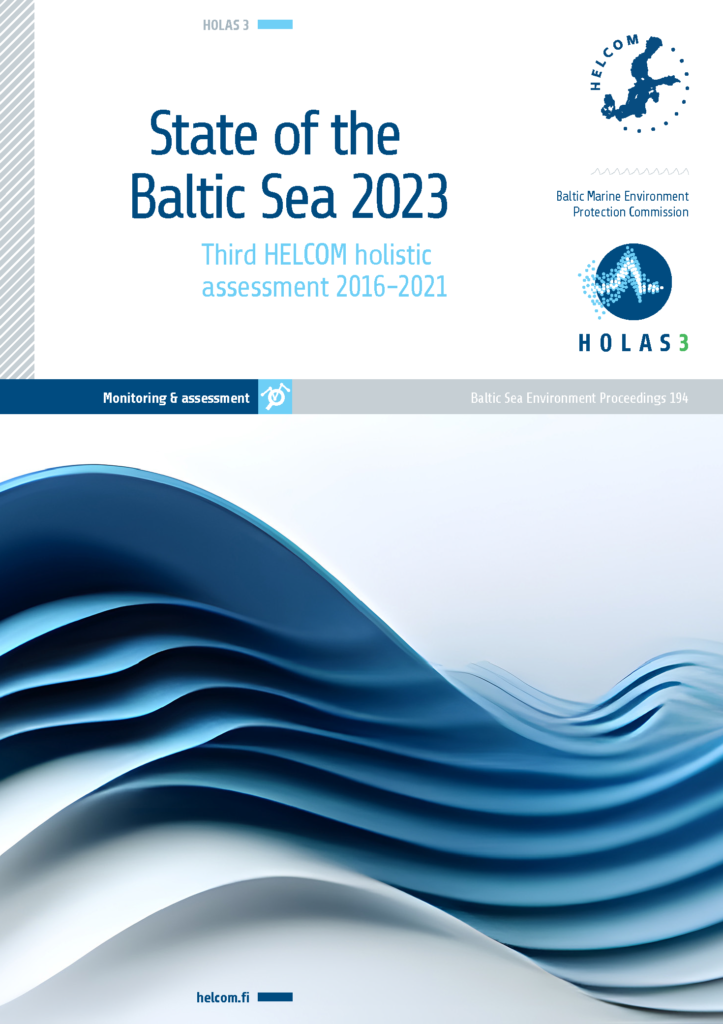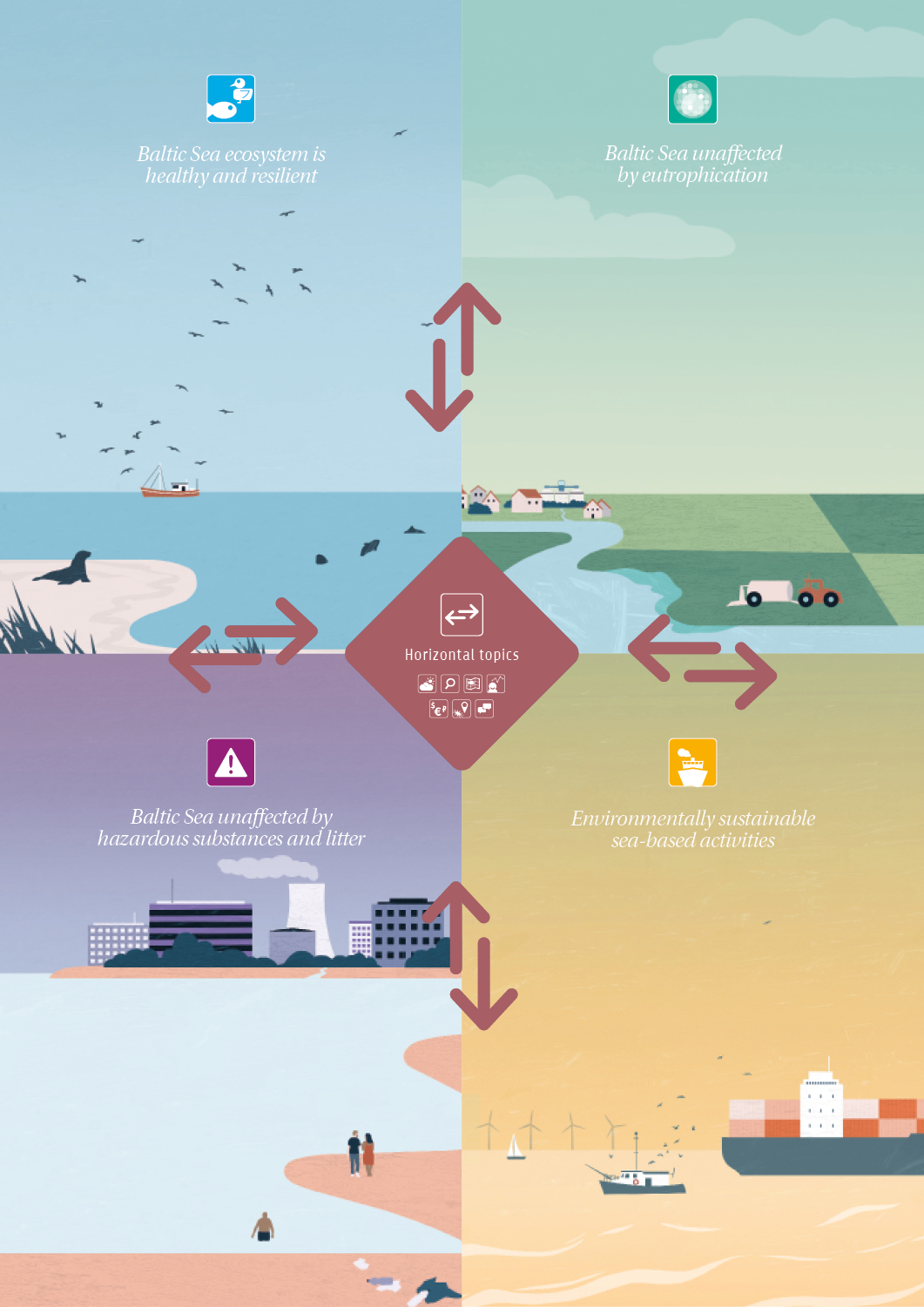POLICY FRAMEWORKS
HOLAS policy use
In HELCOM, the holistic assessment provides a shared basis for following up on progress towards the objectives of the Baltic Sea Action Plan, facilitating the adaptive development of measures for the Baltic Sea environment in alignment with the ecosystem approach.
The results and evaluations can be used to assess the current environmental status of the Baltic Sea and track the progress and effects of existing measures. This work supports several policies of key importance for the marine environment, helping HELCOM countries to come together and agree on the next steps to curb negative impacts and improve the status of the Baltic Sea.
Baltic Sea Action Plan
The Baltic Sea Action Plan (BSAP) is HELCOM’s strategic programme of measures and actions for achieving a good environ- mental status of the sea (HELCOM 2021). The BSAP provides the concrete basis for work in HELCOM by stimulating goal-oriented cooperation among countries in the Baltic Sea region.
The BSAP is guided by the HELCOM vision of “a healthy Baltic Sea environment with diverse biological components functioning in balance, resulting in a good ecological status and supporting a wide range of sustainable economic and social activities”. The 2021 BSAP is divided into four segments, each with specific goals and objectives, which have been jointly agreed amongst the Baltic Sea countries.
Each of the four segments contains concrete measures and actions to be implemented by 2030 at the latest. The Eutrophication and Hazardous substances and litter segments mainly reflect actions needed to manage pressures stemming from land, while the Sea-based activities segment addresses actions needed at sea to curb negative impacts resulting from our marine activities.
The segments of the BSAP are intrinsically linked, and accomplishing the goals of these segments has direct importance for securing the status of species and habitats in the Baltic Sea, which is the target of the Biodiversity segment. The actions under this segment focus primarily on protection and restoration.
The BSAP also includes a number of horizontal topics. These address cross-cutting issues which have the potential to markedly in- fluence the successful implementation of the BSAP. These include climate change, monitoring, maritime spatial planning, economic and social analyses, knowledge exchange and awareness raising, hot spots and financing.
Marine Strategy Framework Directive and other EU legislation
The Marine Strategy Framework Directive (MSFD) is the legal instrument for the protection of the seas in the European Union. The overarching goal of the MSFD is to achieve a good environmental status of the marine waters within the European Union, which is specified using eleven descriptors (Figure 1.2). EU Member States are required to report on the status of their marine environments (using indicators) in relation to these descriptors in six-year assessment cycles (EC 2017 a,b).
While member states define the indicators and their threshold values, they are often required to do so through regional cooperation, and their data collection and assessment approaches need to be as coherent as possible in order to be meaningful, particularly within the same marine region.
The MSFD is an overarching framework that strives to establish an ecosystem-based, adaptive, and integrated approach to the management of all human activities that have an impact on the marine environment. The MSFD does not aim to replace other related EU policies but makes links to them to support harmonised assessment and monitoring.
Examples of EU policies of direct relevance for the implementation of the EU MSFD are the Birds and Habitats Directive (EU 1992), the Water Framework Directive (EC 2000), and the EU Common Fisheries Policy (EU 2013).
Sustainable Development Goals
The HELCOM Baltic Sea Action Plan and HELCOM activities are well aligned with the Sustainable Development Goals of the United Nations, which provide a global blueprint for peace and prosperity for people and our planet (UN 2015).
The seventeen goals were adopted by all United Nations Member States in 2015. Rooted in an urgent call for action by both the Global South and the Global North, the Sustainable Development Goals recognize that ending poverty and other deprivations must go hand-in-hand with strategies that improve health and education, reduce inequality and spur economic growth while tackling climate change and working to preserve our forests and oceans.

State of the Baltic Sea 2023 — The third HELCOM holistic assessment (HOLAS 3)
State of the Baltic Sea 2023 is a synthesis report that builds on, and integrates, results from a wide range of assessment products produced within the third HELCOM holistic assessment. Its role is to link information from the underpinning assessment products together, thus highlighting the holistic aspects. With this in mind, the summary report focuses on presenting the results and on an in-depth look at why we are seeing these results, providing over-arching context and analysis. The report helps develop a clearer picture of where we are and how things are connected, supporting coordinated and effective measures to strengthen the Baltic Sea environment.


